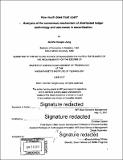| dc.contributor.advisor | Christian Catalini. | en_US |
| dc.contributor.author | Jiang, Jennifer Hongbo | en_US |
| dc.contributor.other | Technology and Policy Program. | en_US |
| dc.date.accessioned | 2017-09-15T15:34:54Z | |
| dc.date.available | 2017-09-15T15:34:54Z | |
| dc.date.copyright | 2017 | en_US |
| dc.date.issued | 2017 | en_US |
| dc.identifier.uri | http://hdl.handle.net/1721.1/111454 | |
| dc.description | Thesis: S.M. in Management of Technology, Massachusetts Institute of Technology, Sloan School of Management, 2017. | en_US |
| dc.description | Cataloged from PDF version of thesis. | en_US |
| dc.description | Includes bibliographical references (pages 47-49). | en_US |
| dc.description.abstract | This paper analyzed how blockchain has achieved decentralized consensus, a remarkable innovation by: 1) validating transactions based on cryptograph technologies and implicit incentives; 2) extending blockchain networks based on a process of randomization. The success of emerging distributed ledger technology (DLT) reveals an intricate interplay of key factors among technology, economics, and rules. This paper discussed the broad spectrum of permissionless and permissioned DLTs and argued that the choice of DLT for each business case is a delicate balancing act for the needs of disintermediation, confidentiality, and scalability among other considerations. Smart contacts are the pre-agreed set of rules evaluated and executed by an automated system based on DLT. By digitalizing the physical business world, smart contracts combined with loT or big data analytics can help make powerful business cases, and we illustrated the potential use-cases in financial securitization industry. Looking forward, a decentralized consensus model empowered by DLT may lead to a new dimension of organizational changes and foster more collaborative partnership within and beyond the financial services industry. | en_US |
| dc.description.statementofresponsibility | by Jennifer Hongbo Jiang. | en_US |
| dc.format.extent | 49 pages | en_US |
| dc.language.iso | eng | en_US |
| dc.publisher | Massachusetts Institute of Technology | en_US |
| dc.rights | MIT theses are protected by copyright. They may be viewed, downloaded, or printed from this source but further reproduction or distribution in any format is prohibited without written permission. | en_US |
| dc.rights.uri | http://dspace.mit.edu/handle/1721.1/7582 | en_US |
| dc.subject | Sloan School of Management. | en_US |
| dc.subject | Technology and Policy Program. | en_US |
| dc.title | How much does trust cost? : analysis of the consensus mechanism of distributed ledger technology and use-cases in securitization | en_US |
| dc.title.alternative | Analysis of the consensus mechanism of distributed ledger technology and use-cases in securitization | en_US |
| dc.type | Thesis | en_US |
| dc.description.degree | S.M. in Management of Technology | en_US |
| dc.contributor.department | Sloan School of Management | |
| dc.identifier.oclc | 1003321586 | en_US |
